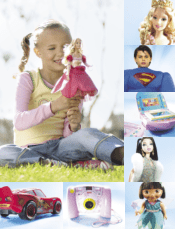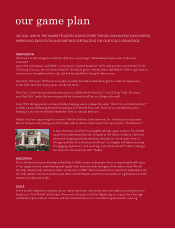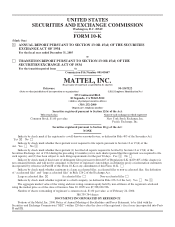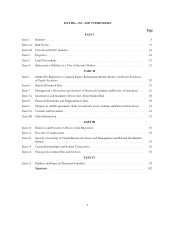Mattel 2005 Annual Report Download - page 14
Download and view the complete annual report
Please find page 14 of the 2005 Mattel annual report below. You can navigate through the pages in the report by either clicking on the pages listed below, or by using the keyword search tool below to find specific information within the annual report.No individual country within the International segment exceeded 7% of worldwide consolidated gross sales
during 2005.
The strength of the US dollar relative to other currencies can significantly affect the revenues and
profitability of Mattel’s international operations. Mattel enters into foreign currency forward exchange and
option contracts, primarily to hedge its purchase and sale of inventory and other intercompany transactions
denominated in foreign currencies, to limit the effect of exchange rate fluctuations on its results of operations and
cash flows. See Item 7A “Quantitative and Qualitative Disclosures About Market Risk” and Item 8 “Financial
Statements and Supplementary Data—Note 8 to the Consolidated Financial Statements.” For financial
information by geographic area, see Item 8 “Financial Statements and Supplementary Data—Note 11 to the
Consolidated Financial Statements.”
Manufacturing and Materials
Mattel manufactures toy products for all segments in both company-owned facilities and through third-party
manufacturers. Products are also purchased from unrelated entities that design, develop and manufacture those
products. To provide greater flexibility in the manufacture and delivery of its products, and as part of a
continuing effort to reduce manufacturing costs, Mattel has concentrated production of most of its core products
in company-owned facilities and generally uses third-party manufacturers for the production of non-core
products.
Mattel’s principal manufacturing facilities are located in China, Indonesia, Thailand, Malaysia and Mexico.
Mattel also utilizes third-party manufacturers to manufacture its products in the US, Mexico, Brazil, Asia, India
and Australia. To help avoid disruption of its product supply due to political instability, civil unrest, economic
instability, changes in government policies and other risks, Mattel produces many of its key products in more
than one facility. Mattel believes that the existing production capacity at its own and its third-party
manufacturers’ manufacturing facilities is sufficient to handle expected volume in the foreseeable future. See
Item 1A “Risk Factors—Factors That May Affect Future Results.”
Mattel bases its production schedules for toy products on customer orders and forecasts, taking into account
historical trends, results of market research and current market information. Actual shipments of products
ordered and order cancellation rates are affected by consumer acceptance of product lines, strength of competing
products, marketing strategies of retailers, changes in buying patterns of both retailers and consumers, and
overall economic conditions. Unexpected changes in these factors could result in a lack of product availability or
excess inventory in a particular product line.
The foreign countries in which most of Mattel’s products are manufactured (principally China, Indonesia,
Thailand, Malaysia and Mexico) all enjoy permanent “normal trade relations” (“NTR”) status under US tariff
laws, which provides a favorable category of US import duties. China’s NTR status became permanent in 2002,
following enactment of a bill authorizing such status upon the country’s accession to the World Trade
Organization (“WTO”), which occurred in 2001. Membership in the WTO substantially reduces the possibility of
China losing its NTR status, which would result in increased costs for Mattel and others in the toy industry.
All US duties on toys were completely eliminated upon implementation of the Uruguay Round WTO
agreement in 1995. The European Union, Japan and Canada eliminated their tariffs on most toy categories
through staged reductions that were completed by January 1, 2004. The primary toy tariffs still maintained by
these countries are European Union and Japanese tariffs on dolls of 4.7% and 3.9%, respectively, and a Canadian
tariff of 8.0% on children’s wheeled vehicles.
The majority of Mattel’s raw materials are available from numerous suppliers but may be subject to
fluctuations in price.
5
























